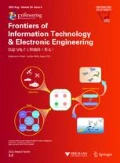Abstract
We develop a new kind of underwater inductive coupling power transfer (ICPT) system to evaluate wireless power transfer in autonomous underwater vehicle (AUV) docking applications. Parameters that determine the performance of the system are systematically analyzed through mathematical methods. A circuit simulation model and a finite element analysis (FEA) simulation model are developed to study the power losses of the system, including copper loss in coils, semiconductor loss in circuits, and eddy current loss in transmission media. The characteristics of the power losses can provide guidelines to improve the efficiency of ICPT systems. Calculation results and simulation results are validated by relevant experiments of the prototype system. The output power of the prototype system is up to 45 W and the efficiency is up to 0.84. The preliminary results indicate that the efficiency will increase as the transmission power is raised by increasing the input voltage. When the output power reaches 500 W, the efficiency is expected to exceed 0.94. The efficiency can be further improved by choosing proper semiconductors and coils. The analysis methods prove effective in predicting the performance of similar ICPT systems and should be useful in designing new systems.
Similar content being viewed by others
References
Babic, S., Akyel, C., 2000. Improvement in calculation of the self- and mutual inductance of thin-wall solenoids and disk coils. IEEE Trans. Magn., 36(4):1970–1975. [doi:10.1109/TMAG.2000.875240]
Dodd, C.V., Deeds, W.E., 1968. Analytical solutions to eddy current probe coil problems. J. Appl. Phys., 39(6):2829–2838. [doi:10.1063/1.1656680]
Dukju, A., Songcheol, H., 2013. A study on magnetic field repeater in wireless power transfer. IEEE Trans. Ind. Electron., 60(1):360–371. [doi:10.1109/TIE.2012.2188254]
Ghahary, A., Cho, B.H., 1992. Design of transcutaneous energy transmission system using a series resonant converter. IEEE Trans. Ind. Electron., 7(2):261–269. [doi:10.1109/63.136242]
Han, J., Asada, A., Ura, T., et al., 2007. Noncontact power supply for seafloor geodetic observing robot system. J. Mar. Sci. Tech., 12(3):183–189. [doi:10.1007/s00773-006-0235-4]
Howe, B.M., McGinnis, T., Gobat, J., 2006. Moorings for ocean observatories: continuous and adaptive sampling. Scientific Submarine Cable Conf., p.172–181.
Hurley, W.G., Gath, E., Breslin, J.G., 2000. Optimizing the AC resistance of multilayer transformer windings with arbitrary current waveforms. IEEE Trans. Power Electron., 15(2):369–376. [doi:10.1109/63.838110]
Kim, Y.H., Jin, K.H., 2012. A contactless power transfer system using a series-series-parallel resonant converter. Int. J. Electron., 99(7):885–897. [doi:10.1080/00207217.2011.653947]
Kojiya, T., Sato, F., Matsuki, H., et al., 2004. Automatic power supply system to underwater vehicles utilizing non-contacting technology. Oceans, p.2341–2345. [doi:10.1109/OCEANS.2004.1406521]
Li, Z., Li, D., Lin, L., et al., 2010. Design considerations for electromagnetic couplers in contactless power transmission systems for deep-sea applications. J. Zhejiang Univ.-Sci. C (Comput. & Electron.), 11(10):824–834. [doi:10.1631/jzus.C0910711]
Low, Z.N., Chinga, R.A., Tseng, R., et al., 2009. Design and test of a high-power high-efficiency loosely coupled planar wireless power transfer system. IEEE Trans. Ind. Electron., 56(5):1801–1812. [doi:10.1109/TIE.2008.2010110]
McEwen, R.S., Hobson, B.W., McBride, L., et al., 2008. Docking control system for a 54-cm-diameter (21-in) AUV. IEEE J. Ocean. Eng., 33(4):550–562. [doi:10.1109/JOE.2008.2005348]
Moulder, J.C., Tai, C.C., Larson, B.F., et al., 1998. Inductance of a coil on a thick ferromagnetic metal plate. IEEE Trans. Magn., 34(2):505–514. [doi:10.1109/20.661482]
Ota, Y., Takura, T., Sato, F., et al., 2011. Impedance matching method about multiple contactless power feeding system for portable electronic devices. IEEE Trans. Magn., 47(10):4235–4237. [doi:10.1109/TMAG.2011.2156399]
Papastergiou, K.D., Macpherson, D.E., 2007a. An airborne radar power supply with contactless transfer of energy. Part I: rotating transformer. IEEE Trans. Ind. Electron., 54(5):2874–2884. [doi:10.1109/TIE.2007.902044]
Papastergiou, K.D., Macpherson, D.E., 2007b. An airborne radar power supply with contactless transfer of energy. Part II: converter design. IEEE Trans. Ind. Electron., 54(5):2885–2893. [doi:10.1109/TIE.2007.901370]
Podder, T., Sibenac, M., Bellingham, J., 2004. AUV docking system for sustainable science missions. IEEE Int. Conf. on Robotics & Automation, p.4478–4484. [doi:10.1109/ROBOT.2004.1302423]
Pyle, D., Granger, R., Geoghegan, B., et al., 2012. Leveraging a large UUV platform with a docking station to enable forward basing and persistence for light weight AUVs. Oceans, p.1–8. [doi:10.1109/OCEANS.2012.6404932]
Scott, K.L., 1930. Variation of the inductance of coils due to the magnetic shielding effect of eddy currents in the cores. Proc. IRE, 18(10):1750–1764. [doi:10.1109/JRPROC.1930.221920]
Sibue, J.R., Meunier, G., Ferrieux, J.P., et al., 2013. Modeling and computation of losses in conductors and magnetic cores of a large air gap transformer dedicated to contactless energy transfer. IEEE Trans. Magn., 49(1):586–590. [doi:10.1109/TMAG.2012.2211031]
Taheri, S., Gholami, A., Fofana, I., et al., 2011. Modeling and simulation of transformer loading capability and hot spot temperature under harmonic conditions. Electr. Power Syst. Res., 86:68–75. [doi:10.1016/j.epsr.2011.12.005]
Villa, J.L., Sallan, J., Sanz Osorio, J.F., et al., 2012. High-misalignment tolerant compensation topology for ICPT systems. IEEE Trans. Ind. Electron., 59(2):945–951. [doi:10.1109/TIE.2011.2161055]
Wang, C.S., Covic, G.A., Stielau, O.H., 2004. Power transfer capability and bifurcation phenomena of loosely coupled inductive power transfer systems. IEEE Trans. Ind. Electron., 51(1):148–157. [doi:10.1109/TIE.2003.822038]
Zargham, M., Gulak, P.G., 2012. Maximum achievable efficiency in near-field coupled power-transfer systems. IEEE Trans. Biomed. Circ. Syst., 6(3):228–245. [doi:10.1109/TBCAS.2011.2174794]
Author information
Authors and Affiliations
Corresponding author
Additional information
Project supported by the National High-Tech R&D Program of China (No. 2013AA09A414), the National Natural Science Foundation of China (No. 51221004), and the Interdisciplinary Research Foundation of Zhejiang University (No. 2012HY003A)
Rights and permissions
About this article
Cite this article
Shi, Jg., Li, Dj. & Yang, Cj. Design and analysis of an underwater inductive coupling power transfer system for autonomous underwater vehicle docking applications. J. Zhejiang Univ. - Sci. C 15, 51–62 (2014). https://doi.org/10.1631/jzus.C1300171
Received:
Revised:
Published:
Issue Date:
DOI: https://doi.org/10.1631/jzus.C1300171
Key words
- Inductive coupling power transfer (ICPT)
- Autonomous underwater vehicle (AUV) docking
- Coupling coefficient
- Resonant capacitance
- Power transfer efficiency
- Power loss
- Eddy current




